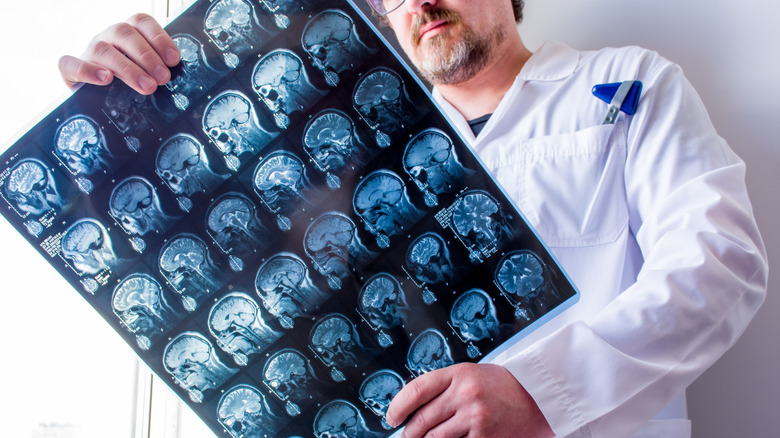Multiple Sclerosis Explained: Causes, Symptoms, And Treatments
Multiple sclerosis (MS) is a progressive disease with no cure that occurs when the immune system attacks the protective sheath that covers nerve fibers in the brain and spinal cord (via Mayo Clinic). MS causes widespread inflammation and lesions that can be temporary or permanent; these lesions make it more difficult for the brain to communicate with the rest of the body, according to Healthline.
Every person with MS is unique, and doctors cannot predict how individuals will progress or which specific symptoms they will develop (via National Multiple Sclerosis Society). While some individuals only experience mild symptoms, others will lose the ability to write, speak, or walk, explained Johns Hopkins Medicine. MS is more common in women than men, and the symptoms often begin between the ages of 20 and 40 (via MedlinePlus). The National Multiple Sclerosis Society reports that nearly 1 million people living with MS in the United States.
There are different types of multiple sclerosis
The American Academy of Family Physicians (AAFP) points out that there are four forms of MS. The first form is transient and is known as clinically isolated syndrome (CIS), a 24-hour episode of symptoms commonly associated with MS. This syndrome occurs due to swollen and damaged myelin. If brain lesions are found during an MRI, the risk of having MS is increased. However, not all people who experience CIS will develop MS, and they may never have another episode.
The AAFP describes another type of multiple sclerosis, relapsing-remitting MS (RRMS), as the most common form of MS. People with RRMS experience relapses (sometimes referred to as flare-ups) in which new symptoms appear or existing symptoms worsen. There are periods of improvement, known as remission, around the relapses.
Only 15 to 20% of people with MS are diagnosed with the form of multiple sclerosis called primary progressive MS, or PPMS, wherein symptoms get steadily worse without remission. The last type of MS is, as the AAFP describes, secondary progressive MS, or SPMS. About half of all people with relapsing-remitting MS will eventually develop SPMS. Unfortunately, in this form of the disease, episodes of remission and relapse increase the level of disability and the number of new brain lesions over time.
Many of the risk factors for multiple sclerosis can't be prevented, but a few can
According to the National Multiple Sclerosis Society, experts believe that a combination of genetic and environmental factors can add to a person's risk of developing MS. Certain patterns regarding sex, genetics, age, geography, and ethnic background have been found among those diagnosed with MS (via National Multiple Sclerosis Society).
Interestingly, MS is more common in areas farthest from the equator. The Cleveland Clinic explains that one mechanism behind this association might be because these regions receive less sunlight and emphasizes that low levels of vitamin D are a known risk factor for the development of MS. Science also shows that exposure to certain viruses and bacteria, such as the virus that causes mono (Epstein-Barr virus or EBV), can trigger MS later in life. In fact, according to the National Multiple Sclerosis Society, "People with a specific immune-related gene and high levels of antibodies to EBV in their blood were nine times more likely to develop MS than those without the gene and with low levels of the antibodies."
The signs and symptoms of multiple sclerosis are easily mistaken for something else
According to Healthline, about 80% of people with MS report fatigue. They also point out that many of the symptoms of MS are multifactorial. For example, difficulty walking can result from numbness in the legs or feet, muscle weakness, difficulty balancing, muscle spasticity, or vision problems. Another example is the vision problems that frequently occur as the first symptoms for people with MS. These issues might include diplopia (double vision), optic neuritis (causing pain or blurry vision), nystagmus (involuntary movement of the eyes), or blindness.
Per Mayo Clinic, people with MS sometimes complain of "electric-shock sensations" that occur with certain movements, especially when bending the neck forward; this is known as the Lhermitte sign. Other symptoms highlighted by the Mayo Clinic include dizziness and slurred speech, as well as bowel, bladder, and sexual function problems. The American Academy of Phfaysicians points out that people with MS may also complain of thinking and memory problems.
There are no specific tests for multiple sclerosis
WebMD outlines a few ways that multiple sclerosis might be diagnosed, explaining that it can be tricky and timely. Your doctor will likely need to rule out other potential causes for your symptoms, which might include stroke, tumor, or pressure on the spinal cord. If those tests come back clear, you will likely be referred to a neurologist.
According to a study published in 2018, "Diagnosis mainly depends on the medical history and neurological examination." MS attacks typically last more than 24 hours in the absence of fever or any infections. The "neurological deficit will develop subacutely" over two to four weeks and will usually resolve, at least to some extent, over six to eight weeks (this resolution might require corticosteroid treatment).
As WebMD explains, doctors will look for damage to at least two areas of your brain and proof that the damage happened at different times. This will necessitate an MRI (magnetic resonance imaging) of the brain to look for lesions. You will also probably need a lumbar puncture so that the doctors can investigate the biochemistry of your cerebrospinal fluid. They will look at the glucose, protein, and other components of the fluid and check for malignant cells (indicating cancer) and bacteria. According to Healthline, an evoked potential test, or EP, might also be ordered. This test is used to measure the electrical activity in the brain when you are stimulated. Electrodes are placed on the head, and electrical signals in certain areas of your brain are measured when you hear, touch, or see things.
Common and rare symptoms of MS
The most common complications, as detailed by Everyday Health, include vision problems, muscle weakness that makes it difficult to lift your foot and walk (known as foot drop), bladder troubles including incontinence and frequent urinary tract infections, bowel dysfunction, difficulty swallowing (called dysphagia) that can lead to malnourishment and dehydration, and breathing problems that increase the risk for lung infections. Sexual problems, mental health changes, and chronic pain can severely impact the quality of life for people suffering from MS.
Everyday Health described the "phantom skin problems" that affect some individuals with MS, making them feel numb or like they are being pricked with pins and needles. The National Multiple Sclerosis Society describes these symptoms, known as dysesthesias, as painful sensations affecting the legs, feet, arms, and hands that feel like "burning, prickling, stabbing, [or] ice cold or electrical sensations."
Verywell Health highlighted several unusual symptoms of MS, including trigeminal neuralgia, which is shock-like or burning pains in the face caused by damage to the fifth cranial nerve and glossopharyngeal neuralgia, caused by damage to the ninth cranial nerve, resulting in pain in the tongue, throat, ear, or tonsils. Verywell Health also noted that between 2 to 5% of people with MS have seizures, and 6% of people with MS experience temporary diminishment or loss of hearing.
Many medications for MS are administered by injection or infusion
Healthline explains that there are multiple infusible disease-modifying drugs currently approved by the FDA to treat MS, including Alemtuzumab, Natalizumab, Mitoxantrone, and Ocrelizumab.
Alemtuzumab (Lemtrada) is reserved for individuals who haven't responded well to other treatments. It works by reducing the body's white blood cells to reduce inflammation and damage to nerve cells. The medication Natalizumab (Tysabri) stops the damaging immune cells from entering the brain and spinal cord. Mitoxantrone is a form of chemotherapy reserved for people with severe MS — it works to suppress the immune system and prevents flare-ups in people with MS. Lastly, Ocrelizumab (Ocrevus) is believed to target the B lymphocytes that are responsible for myelin sheath damage and repair.
Mayo Clinic also describes two types of injectable medications. These are interferon beta medications, which can reduce the frequency and severity of relapses, and glatiramer acetate (Copaxone, Glatopa), which blocks the immune system's attack on myelin.
Oral medications can manage symptoms or modify the disease course
Oral medications can help a person with MS manage their symptoms. According to RxList, Aubagio (Teriflunomide) is an oral medication that modifies immune signals so that the enzyme used to make a necessary component of DNA is inactivated. It is believed to curtail the overactivation of the immune system by curbing the number of white blood cells present in the central nervous system.
Drugs.com describes Gilenya (Fingolimod) as an oral medication that works by halting the movement of lymphocytes into the brain and spinal cord. Tecfidera, approved for the treatment of relapsing types of multiple sclerosis, is an oral medication believed to decrease inflammation and alter immune response. It might also have antioxidant characteristics that safeguard the brain and spinal cord against harm, according to the National Multiple Sclerosis Society.
Ampyra is another oral medication used in treating MS. However, it is not like other MS treatments in that it "won't keep symptoms from getting worse or change the course of the disease," according to WebMD. Instead, it only helps improve walking by helping to alter the electrical signals that travel along nerve fibers in the brain and spinal cord.
Multiple sclerosis requires regular monitoring
As asserted in a paper published in the International Journal of MS Care, sharing health-related information with health care providers could aid in regulating and mitigating the symptoms of multiple sclerosis, while benefiting physical functioning and quality of life. The self-monitoring assessment scale should encompass physical, social, and cognitive conditions common to MS, combined with the patient's ability to manage everyday activities and relationships with others.
Individuals with MS should be seen annually, at a bare minimum. Those receiving certain medications, including natalizumab or fingolimod, should be seen as often as quarterly, according to Medscape. However, the site pointed out that once a relationship has been developed, a large percentage of symptom management can be provided via telephone or videoconferencing. Furthermore, patients with multiple or poorly controlled symptoms or those who are socially isolated might need to be seen more frequently, even every other month.
Physical and occupational therapies can help maintain independence
Moving as much as possible is especially important for individuals with MS; those who don't move much throughout the day can develop pressure ulcers and life-threatening blood clots (via Everyday Health). According to a study in the EPMA Journal, exercise can help to improve energy levels as well as coordination and balance.
Physical and occupational therapies can be beneficial for people with MS. WebMD highlighted the differences between the two types of therapy. A physical therapist can help you set up a fitness program that works around your physical issues so that you can still reach your exercise goals. For instance, a physical therapist educates you on specific stretches and exercises to work on for your flexibility, strength, coordination, and balance. The physical therapist will prioritize activities to improve your range of motion, prevent falls, and build up your activity and independence. On the other hand, occupational therapy strives to help you live as normal a life as possible. This might involve helping you to develop modifications for daily chores, work tasks, and hygiene habits to make life easier and more pleasant.
People with MS are more likely to experience mental health disorders
According to a study in Psychiatric Clinics of North America, depression and anxiety are much more prevalent among people with MS. In fact, major depressive disorder occurs in 7.4% of the general population over 12 months but in 15.7% of the population with MS. Similarly, any anxiety disorder occurs in 25% of the general population but 36% of the MS population over their lifetime. Both conditions have been associated with "decreased adherence to treatment, functional status, and quality of life."
Alcohol and substance abuse are also more likely to occur in those with multiple sclerosis. The MS International Federation explains that a person with MS might miss their life prior to diagnosis and might have self-image and self-esteem issues after diagnosis. People with MS are also more likely to experience bipolar disorder and mood swings, which can be severe.
A small number of MS sufferers experience uncontrollable laughing and crying brought about by MS-related changes in the brain. This is known as the pseudobulbar affect and often goes undiagnosed and untreated (via Multiple Sclerosis News Today). There are many options for finding much-needed support during your MS journey, but the National Multiple Sclerosis Society is a fantastic place to start.
If you or anyone you know is struggling with addiction issues, help is available. Visit the Substance Abuse and Mental Health Services Administration website or contact SAMHSA's National Helpline at 1-800-662-HELP (4357).
Alternative medicine has proven helpful to many with MS
Many people with MS experiment with acupuncture. According to the National Multiple Sclerosis Society, acupuncture might help relieve "pain, spasticity, numbness and tingling, bladder problems, and depression." However, the organization emphasized that acupuncture is not proven to affect the course of the disease and instead should be relied on for symptom relief.
As MDedge revealed, nearly half of the patients with MS smoke marijuana for the physical and mental symptoms that they experience, including pain and insomnia. In clinical trials of smoked marijuana, participants reported that their pain decreased by at least 30%.
Pulsed electromagnetic (PEMF) therapy is another option as it has been shown to improve symptoms of multiple sclerosis in clinical studies, according to Alternative Therapies in Health and Medicine. Electromagnetic therapy is believed to work because of the decrease in inflammation elicited by the treatment (via Healthline).
Biofeedback is used for many health conditions, including MS, to improve the mind-body relationship. Over time, people who practice biofeedback are able to modify their bodily functions by changing their thinking and actions (via MS Focus Magazine). Biofeedback might target brainwaves, breathing, heart rate, muscle response, sweat glands, or temperature. For example, biofeedback might teach you to pinpoint the specific muscles causing your discomfort so that you can develop a strategy for letting go of the tension in that part of your body.
Health disparities are now being recognized
The National Multiple Sclerosis Society asserts that while MS occurs most often in white people of European descent, Black women have a "higher than previously reported risk of developing MS." According to the Accelerated Cure Project, African Americans might have a higher risk of developing MS, and that the disease might be more aggressive when it does strike. Hispanic Americans might have an earlier disease onset and be more prone to disease involvement of the spinal cord and eyes.
The Accelerated Cure Project further pointed out, "Disparities in use and receipt of health services, cultural beliefs, and distrust of the medical profession may also contribute to worse outcomes." Based on the Patient-Derived Multiple Sclerosis Severity Score, "significantly higher disability scores have been reported for both Hispanics and African Americans compared to whites," a 2020 study in the Multiple Sclerosis Journal revealed.
This review points out that, among minorities, there is evidence of poor access to specialists, altered beliefs about the illness that impacts one's ability to engage in self-care, and healthy literacy obstacles. Sadly, a Medicaid long-term managed care plan in New York determined that 30% of low-income minorities with MS have never seen an MS specialist. Another 30% were not taking disease-modifying treatments due to poor compliance and understanding of the drug.
There's good news regarding treatments on the horizon
Although you might be disappointed to learn that more people are diagnosed with MS today than in the past, you can take comfort in the fact that this might be because of greater awareness of the disease and faster diagnosis and treatment. It does not appear that the rate of MS is generally increasing, according to the National Multiple Sclerosis Society. The Society also revealed several other reasons for optimism, including the fact that there are now treatments developed specifically for the treatment and management of MS and more research being done to develop innovative therapies. The faster diagnosis of the disease allows for earlier treatment to slow the progression of the condition.
Scientists are also getting better at identifying risk factors for the disease so that preventive strategies can be developed. Another awesome bit of news: In a 2020 phase 2 clinical trial, the cancer drug bexarotene was found to regenerate the myelin sheath in individuals with MS. While this specific drug has too many adverse side effects to be used for this purpose, it has opened the door for the creation of other, better-tolerated medications that can be used for the same purpose (via Good News Network).














